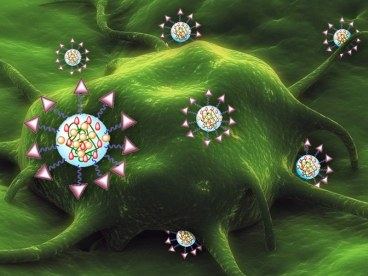What is nanotechnology? What is nanomedicine? In this blog we will look at where nano and medicine meet in the second decade of the 21st century and where we expect to see it go by 2030.
Nanotechnology
I briefly described nanoscale manufacturing in a earlier blog, the building of devices at an atomic or molecular scale. To understand just how tiny this is you need to know what we are measuring when we talk about nanoscale. A nanometer, the standard measure, is one billionth of a meter. That’s the length of 3 to 6 atoms, or a DNA strand. Compare this measure to the width of a human hair – between 50,000 and 100,000 nanometers. So we are really talking small.
The world of nanotechnology has made it possible to build new materials through the manipulation of matter at a molecular level. Our industrial past started out building big things. In electronics we went from vacuum tubes to transistors to integrated circuits, each substantially smaller than the technology it replaced. When we manufactured big things like steel plate we blended iron with nickel but we did this without getting down to the level of molecules and atoms. If we were to examine at a molecular level the end products of this type of manufacturing we would be able to see just how imprecise our processes were.
That is not the case with nanotechnology were we can assemble devices by building them an atom at a time. Today we hear about nanotubes made from carbon. We see articles in the paper describing molecular motors and nanowires that operate drawing their power from the weakest of forces, the interaction involving attraction repulsion between molecules first described by Johannes Diderik van der Waals in the latter part of the 19th century. Van der Waals went on to win the Nobel Prize for Physics in 1910.

In Isaac Asimov’s science fiction novel, Fantastic Voyage, he relates a tale involving a science that shrinks atoms temporarily to a scale so small that a submersible along with its crew can be injected into the bloodstream of a scientist who has suffered a blood clot in the brain. Asimov’s tale, like much of science fiction, has provided inspiration to researchers who see in it the potential promise of nanobots that can sail the inner seas of our blood and lymphatic systems repairing cells, defeating cancer and extending our lives. Of course Asimov’s story, an adaptation of a movie script, used a matter transformer to shrink atoms and molecules, not nanotechnology.
Some scientists argue that nanotechnology has a dark side. In Michael Crichton’s novel, Prey, nanobots escape from a research laboratory, replicate, evolve and form intelligent swarms becoming a threat to humanity and life on Earth.
Nanomedicine
The nanobots in our future are far more benign and helpful than those proposed in Crichton’s novel. Let’s look at how we will exploit them and other nanotechnologies for good in the field of biomedicine. Researchers identify a number of exciting uses including:
- Nanoparticle drug delivery
- Nanorobotics
- Nanoelectronics
- Nanovaccinology
Nanoparticle Drug Delivery
MIT engineers in association with Brigham and Women’s Hospital in Boston have created synthetic nanoparticles that pass through the outer membrane of prostate cancer cells to deliver cisplatin and docetaxel, to target tumor cells. The initial challenge involved developing a nanoparticle that would pass through a cell membrane without rupturing it. Normally a cell membrane eats or encases and ejects foreign objects such as nanoparticles. But by creating synthetic materials that closely resemble the cell membrane the researchers have tricked the cells into accepting the nanoparticle intrusion.

The next challenge involved giving the nanoparticle the capability of recognizing the special characteristics of specific tumor cells. This required the development of tags that specifically bind to molecules found on the surface of these cells. Developing nanoparticles that can be so specific means healthy cells don’t experience the drug interactions, minimizing side effects. For chemotherapy treatment nanoparticles represent, therefore, a breakthrough in cancer treatment. The research team at MIT are working on adapting nanoparticles to treat other cancers.
Nanorobotics
Nanorobots for medicine are in our very near future. None exists today. What defines a nanorobot? This is a molecularly-manufactured machine constructed from atoms and molecules with dimension ranging from 1 to 100 nanometers. Currently carbon, nitrogen and oxygen are the elements of choice because they have a higher acceptance rate within the body with less likelihood of a rejection response brought on by the immune system. Powered by using glucose and oxygen for energy sources, or by an external power source, nanorobots would roam through the body serving general maintenance of our bodies or specific tasks focused on killing pathogens or repairing damaged organs and body tissue. A nanorobot would feature an onboard computer, sensors, signal processors and communications technology.
Nanorobots may be used in groups relying on group intelligence. Several may serve as navigation beacons to help others of their kind to navigate through the body, and to accurately relay position location to external monitors. Like their nanoparticle brethren, nanorobots will include tagged information to distinguish health cells from those being targeted.
Nanorobots can be designed to be very task specific so that once the job is done they can be retrieved or excreted, or degrade to be removed by the immune system. Others can be designed to permanently police the body to compliment the immune system in dealing with diseases or required repairs. Others may just act as biosensors constantly relaying health information periodically to external monitors.
Nanorobots could serve as arterial cleaners constantly scouring the walls of blood vessels to eliminate potential blockages. They could be used to permanently eliminate gum disease by removing plaque and tartar and policing the mouth to ensure good dental health. They could be applied in a lotion to deal with basic chronic skin problems like acne. They could target specific pathogens and destroy them working in harmony with the body’s immune system.
Nanoelectronics
For diseases such as Alzheimer’s and Parkinson’s there are no known cures. There are challenges in trying to treat brain injuries. Our bodies have a blood-brain barrier that acts as a selective filter isolating brain tissue from the rest of the body. This makes it difficult to deliver treatment through the normal body transport systems.
But nanotechnology may prove to be a means by which the process of brain degeneration is stopped and potentially reversed. This means creating nanotechnology that can cross the blood-brain barrier and be released in the brain to deliver therapy. Described as Trojan Horses, such nanotechnology would consist of an encapsulated molecule that is not seen as a threat by the body’s immune system. The molecule would be designed to degrade and release its hidden inner nano components or drugs specifically targeted to the area of the brain affected by the disease. In the case of Alzheimer’s, current investigations are looking at delivering Rivastigmine and Acetylcholine using biodegradable polymeric nanoparticles.
What if the same molecule could deliver a device and not a drug? That device could contain nanoelectronics that could replace degenerated neurons and provide new neural pathways within the brain. Curved carbon presents opportunities to develop devices on a nano scale that may lead to brain implants to enhance cognition and memory or restore motor function control. The next decade should see significant progress in nanoelectronics focused on brain-related diseases and spinal cord injuries.
Nanovaccinology
Current vaccines use adjuvant, chemicals designed to enhance the immune response to whatever is being targeted. For some people adjuvant can cause negative antibody responses leading to complications. Replacing adjuvant with nanoparticles combined with the vaccine could eliminate these types of bad reactions.
Better yet, nanotechnology can be used to eliminate the needle in vaccine delivery. Researchers at the University of Queensland, Australia, have developed a Nanopatch, a needle-free method of delivering vaccines. The Nanopatch is smaller than a postage stamp. Each contains thousands of tiny projections that when placed on skin delivers sera biomolecularly. The Nanopatch activates when placed on skin becomes moist and dissolves within minutes. Used for influenza vaccine delivery, the Nanopatch is being considered as an effective tool for delivering vaccines against West Nile and Chukunga virus.








